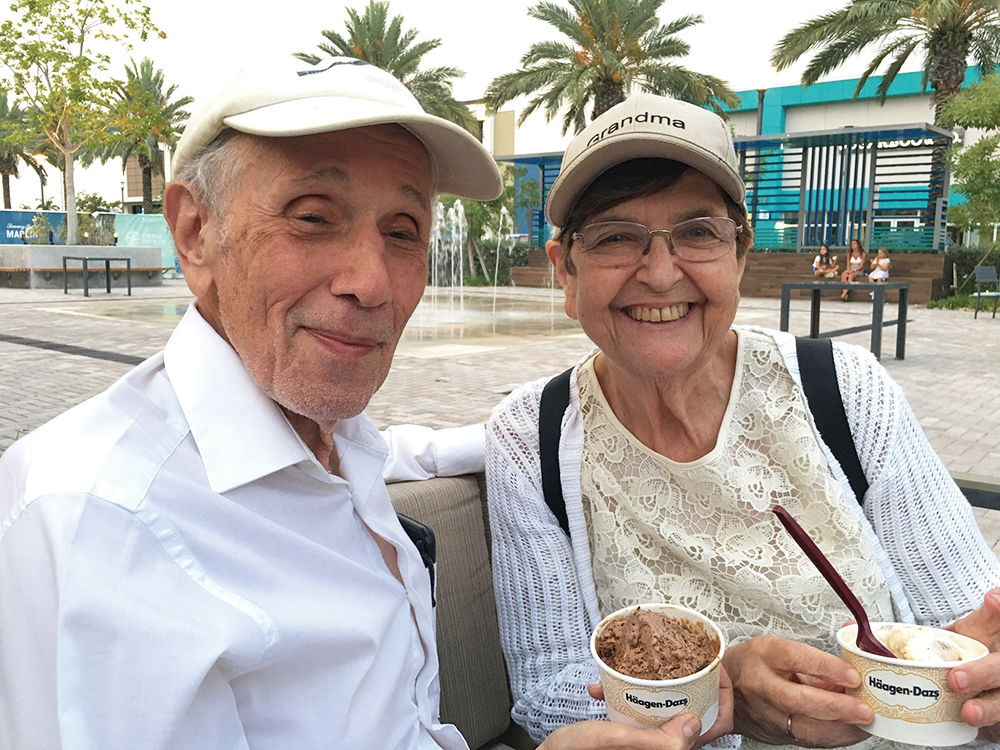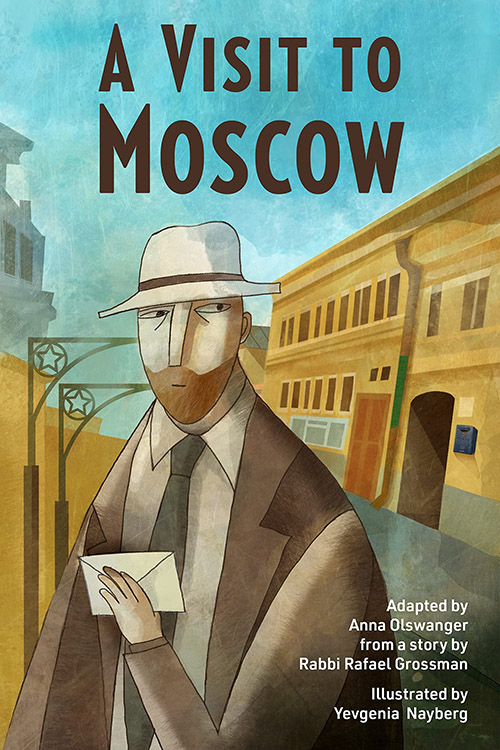Highlighting: “A Visit to Moscow” by Anna Olswanger. West Margin Press. 2022. English. Hardcover. 72 pages. ISBN-13: 978-1513128733.

An evocative book can transport the reader out of the quotidian and into another time or place. Such is certainly the case with Anna Olswanger’s “A Visit to Moscow” (West Margin Press), an ethereal, dream-like graphic memoir for middle-graders and the adults around them about a time when the Jewish community was activated to respond as one to the plight of Soviet Jewry.
This is why my husband, Dr. Richard Rosenbluth, and I, long-time Englewood residents, decided to donate Olswanger’s book to the public library in Bradley Beach, where we maintain a second home. In the book’s transcription, we honored Bradley Beach Police Chief Leonard A. Guida and his department for their sensitivity to the issue of antisemitism as well as their concern for the security of Congregation Agudath Achim and the local Jewish community, especially in light of the growing number of recent antisemitic incidents throughout New Jersey.
It was important to us to make sure Chief Guida and the officers of his department know how grateful we are for their efforts on our behalf—and for all residents of Bradley Beach. It came as no surprise to us that the Bradley Beach Police Department was recently singled out for praise by those monitoring antisemitism. As Chief Guida has said, “It won’t happen in Bradley Beach on my watch.”
And for that, we are most appreciative.
American Ingenuity
“A Visit to Moscow” was adapted by Olswanger, now a Fair Lawn resident, from a true account by the revered American Torah giant Rabbi Rafael Grossman, zt”l. In 1965, he was part of an early mission to the Soviet Union, undertaken by nine Orthodox rabbis and sponsored by the Rabbinical Council of America.
The Russians hoped that by allowing Western clergymen to make such visits, all of them carefully orchestrated to show only what Moscow chose to put on display, the propaganda would influence residents of the Free World to regard the “workers’ paradise” more fondly.
The Soviets had not counted on the ingenuity and drive of Jewish leaders like Rabbi Grossman as well as laymen inspired by their example.
Years-Long Persecution
 For years, the worldwide Jewish community had heard rumors of the terrible persecution faced by their coreligionists behind the Iron Curtain. This included not only prison for crimes ranging from lighting candles on Friday night to secretly teaching Torah (or even just reading outlawed pamphlets, the so-called samizdat, or books, such as the novel still credited by many former Soviet Jews with spurring their reawakening, Leon Uris’s “Exodus”), but also the crushing poverty that often resulted from the Soviets’ first act of retaliation against anyone who dared ask permission to emigrate to Israel. Virtually all of them were denied, and most of these so-called “refuseniks” were subsequently fired from whatever positions they held.
For years, the worldwide Jewish community had heard rumors of the terrible persecution faced by their coreligionists behind the Iron Curtain. This included not only prison for crimes ranging from lighting candles on Friday night to secretly teaching Torah (or even just reading outlawed pamphlets, the so-called samizdat, or books, such as the novel still credited by many former Soviet Jews with spurring their reawakening, Leon Uris’s “Exodus”), but also the crushing poverty that often resulted from the Soviets’ first act of retaliation against anyone who dared ask permission to emigrate to Israel. Virtually all of them were denied, and most of these so-called “refuseniks” were subsequently fired from whatever positions they held.
Being fired in the Soviet Union was no joke. Not producing a salary led to the terrifying designation of “parasite,” a political crime that was fostered not only upon the breadwinner but also his family and sometimes his friends and associates.
These “parasites” were often saved by financial aid and gifts brought by American supporters, many of whom fell into two categories: those who supported “quiet diplomacy,” which meant finding ways to help Soviet Jews without attracting attention; and those who engaged in public, often loud demonstrations.
An American Spiritual Army
Rabbi Grossman was among the latter. A native of Lakewood, New Jersey, who, after serving at Congregation Brothers of Israel in Long Branch and establishing a kollel in Fort Lee, he went on to become, for nearly 30 years, the spiritual leader of the Orthodox Baron Hirsch Synagogue in Memphis, as well as chairman of the Religious Zionists of America. He told the story recounted in “A Visit to Moscow” hundreds of times: to political and religious leaders of all stripes, reporters and citizens—Jews and Gentiles—who would listen at rallies, sermons and talks throughout the country.
Like most Jews who traveled to Russia to help, Rabbi Grossman arrived with an address. His was supplied by a Jewish woman who had read that he would be traveling with a rabbinical delegation to Russia. She hadn’t seen or heard from her brother in more than 10 years and wanted to know only if he was still alive and had “a bed to sleep in and food to eat.”
Finding the brother was hard (the rabbi first had to shake his Soviet minder and feign illness to get out of a scheduled tour); getting him to talk was even harder. Meyer Gurwitz denied his name, his relationship to the woman, and even his mother tongue, Yiddish. Rabbi Grossman came dressed in a tan hat and Western-style suit; the rabbis Gurwitz recognized wore black coats and hats.
Frightened the rabbi might be a KGB stooge nosing out Jews for persecution, the brother relented only when the two men discussed family members they had lost in the Holocaust.
Hidden in the Apartment
Gurwitz allowed the rabbi into his tiny apartment only after the American swore on the Torah not to tell anyone in the Soviet Union what he would find within.
The story of personal suffering as experienced by the Gurwitz family in secret inside that apartment is what gives “A Visit to Moscow” its raw taste of truth and sense of bitter remembrance of what Jews throughout history have managed to bear and withstand in order to abide by their faith and pass it on to another generation.
That Rabbi Grossman was able to help the family once he returned to America, thus redeeming the faith and trust Gurwitz had placed in him, should bring a lump to the throat of any Jew who was active during those heady days when the community fought as one—whether quietly or noisily—to redeem and rescue Soviet Jews.
Those efforts eventually brought over half a million Russian Jews to the United States and more than twice that number to Israel.
Award-Winning Creators
Olswanger, an award-winning author as well as literary agent and teacher, is known for her Jewish-themed children’s books, most of which, like “A Visit to Moscow,” have been eagerly devoured by adults as well as kids for their poignant takes on history, universally flawed humanity, and the power of friendship. A former congregant of Rabbi Grossman’s in Memphis, she began interviewing him for a collaboration back in the early 1980s.
The book’s haunting illustrations are by award-winning artist Yevgenia Nayberg, who was born in Kiev when it was still part of the USSR. In her notes, included in the book, she says she strove “to avoid the clichés associated with the Soviet Union and remain truthful to what I knew.”
The book includes an afterword by Rabbi Grossman’s son, Dr. Hillel Grossman, a New York psychiatrist, and an essay, “A Saga of Soviet Jewry,” by Rabbi Aaron Rakeffet-Roth, professor of rabbinic literature at Yeshiva University’s Gruss Institute in Jerusalem and the renowned biographer of Rabbi Joseph B. Soloveitchik, zt”l.
“A Visit to Moscow” should be read by anyone, adults and children, who would do well to know something about the suffering of those forced to experience the yoke of tyranny and oppression—and the efforts of heroic, selfless people who go out of their way to help them. One day, those children may be called upon to undertake such actions. When they do, they will stand on the shoulders of giants such as Rabbi Grossman.
Susan L. Rosenbluth is the editor-in-chief of The Jewish Voice and Opinion and TheJewishVoiceAndOpinion.com









